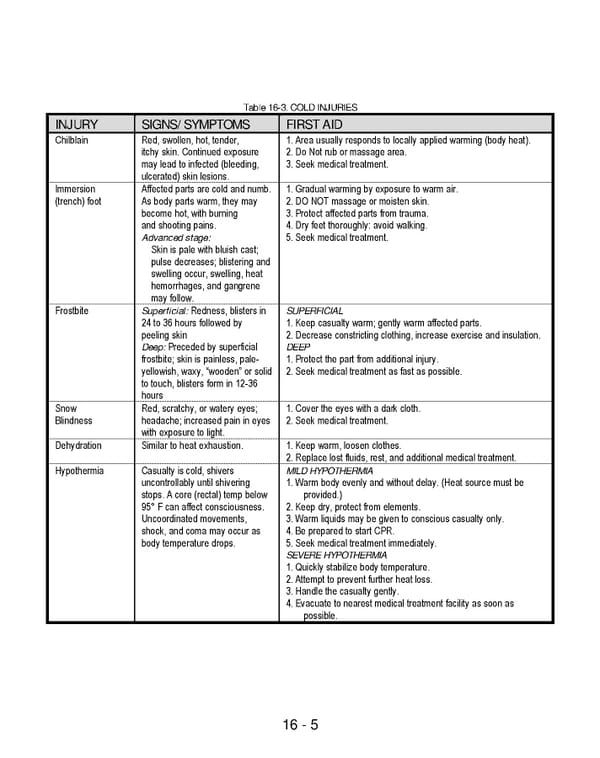16 - 5 Table 16-3. COLD INJURIES INJURY SIGNS/ SYMPTOMS FIRST AID Chilblain Red, swollen, hot, tender, itchy skin. Continued exposure may lead to infected (bleeding, ulcerated) skin lesions. 1. Area usually responds to locally applied warming (body heat). 2. Do Not rub or massage area. 3. Seek medical treatment. Immersion (trench) foot Affected parts are cold and numb. As body parts warm, they may become hot, with burning and shooting pains. Advanced stage: Skin is pale with bluish cast; pulse decreases; blistering and swelling occur, swelling, heat hemorrhages, and gangrene may follow. 1. Gradual warming by exposure to warm air. 2. DO NOT massage or moisten skin. 3. Protect affected parts from trauma. 4. Dry feet thoroughly: avoid walking. 5. Seek medical treatment. Frostbite Superficial: Redness, blisters in 24 to 36 hours followed by peeling skin Deep: Preceded by superficial frostbite; skin is painless, pale- yellowish, waxy, “wooden” or solid to touch, blisters form in 12-36 hours SUPERFICIAL 1. Keep casualty warm; gently warm affected parts. 2. Decrease constricting clothing, increase exercise and insulation. DEEP 1. Protect the part from additional injury. 2. Seek medical treatment as fast as possible. Snow Blindness Red, scratchy, or watery eyes; headache; increased pain in eyes with exposure to light. 1. Cover the eyes with a dark cloth. 2. Seek medical treatment. Dehydration Similar to heat exhaustion. 1. Keep warm, loosen clothes. 2. Replace lost fluids, rest, and additional medical treatment. Hypothermia Casualty is cold, shivers uncontrollably until shivering stops. A core (rectal) temp below 95° F can affect consciousness. Uncoordinated movements, shock, and coma may occur as body temperature drops. MILD HYPOTHERMIA 1. Warm body evenly and without delay. (Heat source must be provided.) 2. Keep dry, protect from elements. 3. Warm liquids may be given to conscious casualty only. 4. Be prepared to start CPR. 5. Seek medical treatment immediately. SEVERE HYPOTHERMIA 1. Quickly stabilize body temperature. 2. Attempt to prevent further heat loss. 3. Handle the casualty gently. 4. Evacuate to nearest medical treatment facility as soon as possible.
 Ranger Handbook Page 300 Page 302
Ranger Handbook Page 300 Page 302